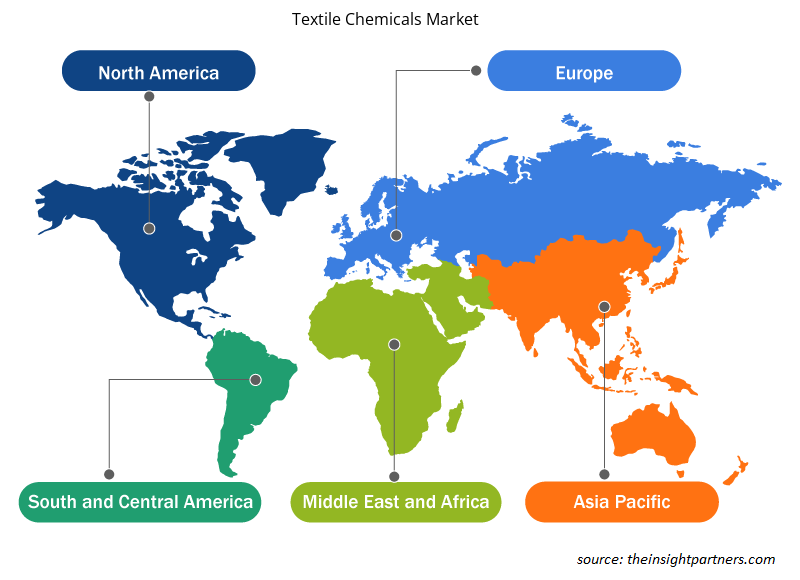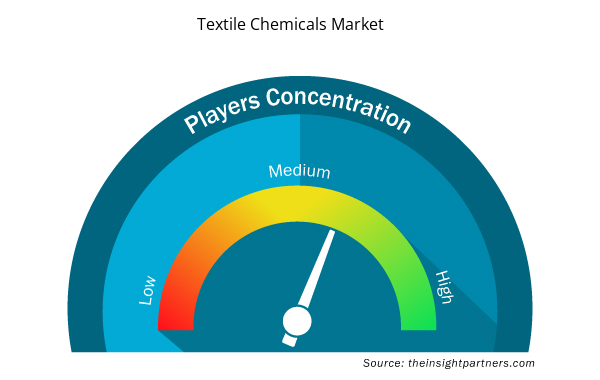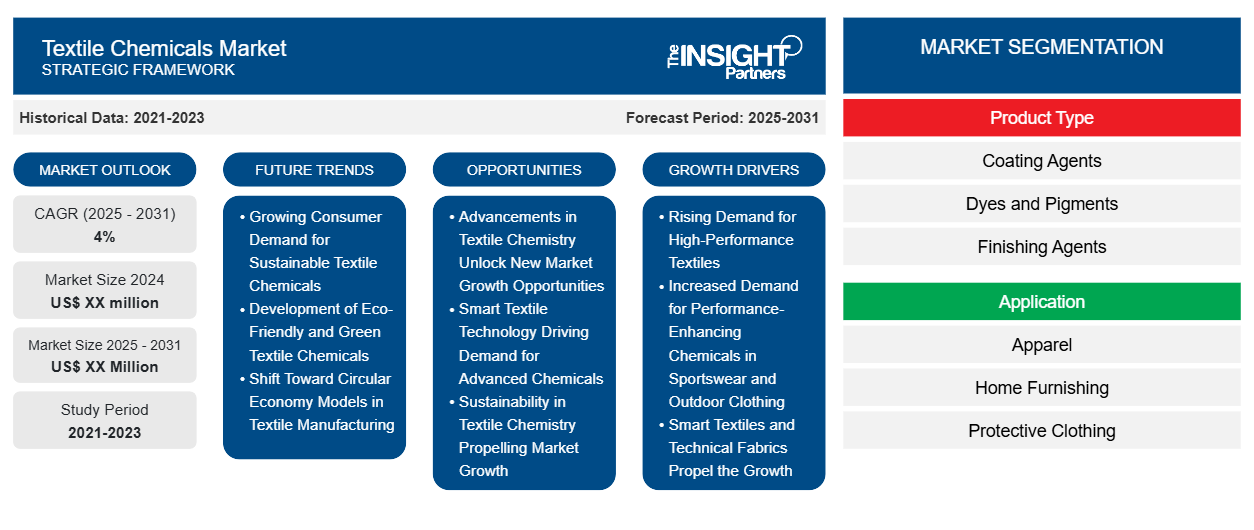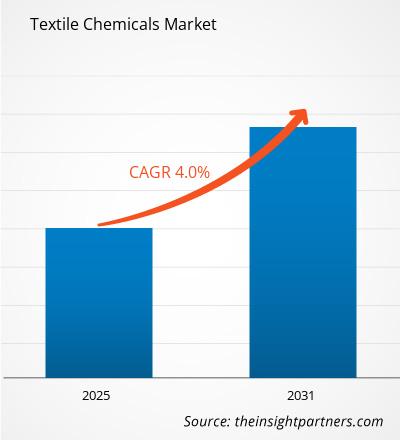Se espera que el mercado de productos químicos textiles registre una CAGR del 4% entre 2024 y 2031, con un tamaño de mercado que se expandirá de US$ XX millones en 2024 a US$ XX millones en 2031.
El informe presenta un análisis basado en el tipo de producto (agentes de recubrimiento, tintes y pigmentos, agentes de acabado, surfactantes, agentes desencolantes y otros). El informe está segmentado por aplicación (ropa, muebles para el hogar, ropa protectora y otros). El análisis global se desglosa aún más a nivel regional y por países principales. El tamaño del mercado y el pronóstico a nivel global, regional y nacional para todos los segmentos clave del mercado están cubiertos bajo el alcance. El informe ofrece el valor en USD para el análisis y los segmentos anteriores. El informe proporciona estadísticas clave sobre el estado del mercado de los actores clave del mercado y ofrece tendencias y oportunidades del mercado.
Propósito del Informe
El informe Textile Chemicals Market de The Insight Partners tiene como objetivo describir el panorama actual y el crecimiento futuro, los principales factores impulsores, los desafíos y las oportunidades. Esto proporcionará información a diversas partes interesadas del negocio, como:
- Proveedores/fabricantes de tecnología: Para comprender la dinámica cambiante del mercado y conocer las oportunidades potenciales de crecimiento, lo que les permitirá tomar decisiones estratégicas informadas.
- Inversionistas: Realizar un análisis exhaustivo de tendencias sobre la tasa de crecimiento del mercado, las proyecciones financieras del mercado y las oportunidades que existen en toda la cadena de valor.
- Órganos reguladores: Regular las políticas y vigilar las actividades del mercado con el objetivo de minimizar los abusos, preservar la confianza de los inversores y defender la integridad y la estabilidad del mercado.
Segmentación del mercado de productos químicos textiles
Tipo de producto
- Agentes de recubrimiento
- Tintes y pigmentos
- Agentes de acabado
- Surfactantes
- Agentes de desencolado
Solicitud
- Vestir
- Mobiliario para el hogar
- Ropa protectora
Personalice este informe según sus necesidades
Obtendrá personalización en cualquier informe, sin cargo, incluidas partes de este informe o análisis a nivel de país, paquete de datos de Excel, así como también grandes ofertas y descuentos para empresas emergentes y universidades.
- Obtenga las principales tendencias clave del mercado de este informe.Esta muestra GRATUITA incluirá análisis de datos, desde tendencias del mercado hasta estimaciones y pronósticos.
Factores impulsores del crecimiento del mercado de productos químicos textiles
- Demanda creciente de textiles de alto rendimiento: la creciente demanda de textiles de alto rendimiento es uno de los principales factores que impulsan el crecimiento de este mercado de productos químicos textiles. Existen varios tipos de industrias que requieren tratamientos químicos especializados en textiles de alto rendimiento para mejorar la durabilidad, la absorción de la humedad, la resistencia al fuego, etc. Por lo tanto, los productos químicos textiles avanzados tienen una gran demanda.moisture-wicking, flame resistance, and so on. Thus, advanced textile chemicals are in huge demand.
- Mayor demanda de productos químicos que mejoran el rendimiento en la ropa deportiva y de actividades al aire libre: a medida que las industrias textiles buscan productos más funcionales, aumenta la demanda de productos químicos que ofrezcan un mejor rendimiento. Por ejemplo, los productos químicos que mejoran la resistencia, elasticidad y resistencia de los tejidos a los rayos UV encuentran importantes aplicaciones en la ropa deportiva y de actividades al aire libre. Este es uno de los factores que explican el crecimiento del mercado de productos químicos textiles, ya que los fabricantes están invirtiendo en soluciones químicas novedosas.
- Los tejidos inteligentes y los tejidos técnicos impulsan el crecimiento: los tejidos inteligentes y los tejidos técnicos que contienen sensores o materiales conductores son una industria emergente. Estos tejidos requieren productos químicos para los complejos procesos de fabricación a los que se someten sin comprometer la funcionalidad de la electrónica integrada. Con una base de aplicaciones en crecimiento para los tejidos inteligentes, su mercado de productos químicos textiles está en rápida expansión gracias a productos especiales.
Tendencias futuras del mercado de productos químicos textiles
- Demanda creciente de productos químicos textiles sostenibles por parte de los consumidores: la creciente preferencia de los consumidores por productos sostenibles es una de las tendencias futuras más importantes que impulsan el crecimiento del mercado de productos químicos textiles. Los consumidores, cada vez más conscientes del medio ambiente, tienden a exigir productos textiles más respetuosos con el medio ambiente. Esta tendencia ha obligado a los fabricantes a adoptar productos químicos textiles sostenibles que minimicen el impacto ambiental y mantengan al mismo tiempo los estándares de entrega de productos de alta calidad.
- Desarrollo de productos químicos textiles ecológicos y respetuosos con el medio ambiente: el desarrollo de productos químicos ecológicos, como tintes biodegradables, acabados a base de agua y tratamientos ecológicos para tejidos, tiene efectos muy beneficiosos en las emisiones, el consumo de agua y los niveles de residuos tóxicos producidos durante la fabricación, y cumple tanto con las expectativas normativas como con las de los consumidores. Esto da impulso al crecimiento del mercado a medida que los fabricantes cambian a alternativas más ecológicas.
- Cambio hacia modelos de economía circular en la fabricación de textiles: La mayor presión sobre las industrias de la moda y los textiles es operar a través de modelos de economía circular mediante los cuales los productos se reciclen en lugar de desecharse, y los textiles químicos que no dañen el proceso de reciclabilidad de los tejidos sean altamente considerados. El mercado de productos químicos textiles ya está evolucionando para ofrecer soluciones que funcionen con la sostenibilidad como eje central.
Oportunidades de mercado de productos químicos textiles
- Advancements in Textile Chemistry Unlock New Market Growth Opportunities: The market of textile chemicals is wide open for enormous growth opportunities, given the advances in textile chemistry. New formulations and processes, for example, would enable the production of high-performance and more effective products; in addition, there is a requirement for specialized chemicals to respond to the ever-increasing need for durability features, moisture management, or protection against UV light in textiles.
- Smart Textile Technology Driving Demand for Advanced Chemicals: Further, smart technology infusion into textiles is spurring demand for advanced chemicals in textiles smarts. That is, smart textiles designed to incorporate conductive materials or sensors will need chemicals to keep them working well. Since the application is growing into healthcare, electronics, and sports apparel, the growth of textile chemicals could be improved.
- Sustainability in Textile Chemistry Propelling Market Growth: Advances in sustainable textile chemistry also play a prominent role in the market growth. Eco-friendly and biodegradable chemicals, such as water-based dyes and non-toxic finishes, are being developed to improve the sector's shift toward greener production processes. Thus, environmentally friendly textile chemicals are gaining momentum. Consumers are increasingly seeking eco-friendly products, while environmental legislation is becoming stricter.
Textile Chemicals Market Regional Insights
The regional trends and factors influencing the Textile Chemicals Market throughout the forecast period have been thoroughly explained by the analysts at Insight Partners. This section also discusses Textile Chemicals Market segments and geography across North America, Europe, Asia Pacific, Middle East and Africa, and South and Central America.

- Get the Regional Specific Data for Textile Chemicals Market
Textile Chemicals Market Report Scope
| Report Attribute | Details |
|---|---|
| Market size in 2024 | US$ XX million |
| Market Size by 2031 | US$ XX Million |
| Global CAGR (2024 - 2031) | 4% |
| Historical Data | 2021-2023 |
| Forecast period | 2025-2031 |
| Segments Covered | By Product Type
|
| Regions and Countries Covered | North America
|
| Market leaders and key company profiles |
|
Textile Chemicals Market Players Density: Understanding Its Impact on Business Dynamics
El mercado de productos químicos para textiles está creciendo rápidamente, impulsado por la creciente demanda de los usuarios finales debido a factores como la evolución de las preferencias de los consumidores, los avances tecnológicos y una mayor conciencia de los beneficios del producto. A medida que aumenta la demanda, las empresas amplían sus ofertas, innovan para satisfacer las necesidades de los consumidores y aprovechan las tendencias emergentes, lo que impulsa aún más el crecimiento del mercado.
La densidad de actores del mercado se refiere a la distribución de las empresas o firmas que operan dentro de un mercado o industria en particular. Indica cuántos competidores (actores del mercado) están presentes en un espacio de mercado determinado en relación con su tamaño o valor total de mercado.
Las principales empresas que operan en el mercado de productos químicos textiles son:
- Akzo Nobel NV
- Arqueroma
- Grupo Bozzetto
- DowDuPont
- DyStar Singapur Pte Ltd
Descargo de responsabilidad : Las empresas enumeradas anteriormente no están clasificadas en ningún orden particular.

- Obtenga una descripción general de los principales actores clave del mercado de productos químicos textiles
Puntos de venta clave
- Cobertura integral: el informe cubre de manera integral el análisis de productos, servicios, tipos y usuarios finales del mercado de productos químicos textiles, proporcionando un panorama holístico.
- Análisis de expertos: el informe se compila sobre la base de un profundo conocimiento de expertos y analistas de la industria.
- Información actualizada: El informe asegura relevancia comercial debido a su cobertura de información reciente y tendencias de datos.
- Opciones de personalización: este informe se puede personalizar para satisfacer los requisitos específicos del cliente y adaptarse adecuadamente a las estrategias comerciales.
Por lo tanto, el informe de investigación sobre el mercado de productos químicos textiles puede ayudar a abrir camino para descifrar y comprender el escenario de la industria y las perspectivas de crecimiento. Si bien puede haber algunas preocupaciones válidas, los beneficios generales de este informe tienden a superar las desventajas.
- Análisis histórico (2 años), año base, pronóstico (7 años) con CAGR
- Análisis PEST y FODA
- Tamaño del mercado Valor/volumen: global, regional, nacional
- Industria y panorama competitivo
- Conjunto de datos de Excel



Report Coverage
Revenue forecast, Company Analysis, Industry landscape, Growth factors, and Trends

Segment Covered
This text is related
to segments covered.

Regional Scope
North America, Europe, Asia Pacific, Middle East & Africa, South & Central America

Country Scope
This text is related
to country scope.
Preguntas frecuentes
Rising consumer preference for sustainable products is expected to be the key market trends.
Based on geography, Asia Pacific held the largest share of the textile chemicals market, as the countries like China, India, and Bangladesh are major manufacturing hubs, producing a vast volume of textiles and garments, which creates a high demand for textile chemicals in processes like dyeing, finishing, and printing.
Based on product type, the coating agents segment is expected to witness the fastest growth during the forecast period
The growing demand for high-performance textiles is driving the market growth.
BASF SE; Archroma; Huntsman Corporation; DyStar Group; Tanatex Chemicals; Kyung-In Synthetic Corporation (KISCO); NICCA Chemicals Co. Ltd; Indofil Industries Limited; Rudolf GmbH; and Sumitomo Chemical Co. Ltd are some of textile chemicals market
The Textile Chemicals Market is estimated to witness a CAGR of 4% from 2023 to 2031
Trends and growth analysis reports related to Chemicals and Materials : READ MORE..
The List of Companies
- Akzo Nobel NV
- Archroma
- Bozzetto Group
- DowDuPont
- DyStar Singapore Pte Ltd
- Evonik Industries AG
- Huntsman International LLC
- Rudolf GmbH
- Tanatex Chemicals B.V.
- Wacker Chemie AG
- Univar Inc
- Kolor Jet Chemical Pvt. Ltd
- Jay Chemical Industries Ltd.
- Chungyo Chem
- Transfar Group Co., Ltd.
- Omya
- The Lubrizol Corporation
- Sumitomo Chemicals Co. Ltd
- Buckman
- Sarex
The Insight Partners performs research in 4 major stages: Data Collection & Secondary Research, Primary Research, Data Analysis and Data Triangulation & Final Review.
- Data Collection and Secondary Research:
As a market research and consulting firm operating from a decade, we have published and advised several client across the globe. First step for any study will start with an assessment of currently available data and insights from existing reports. Further, historical and current market information is collected from Investor Presentations, Annual Reports, SEC Filings, etc., and other information related to company’s performance and market positioning are gathered from Paid Databases (Factiva, Hoovers, and Reuters) and various other publications available in public domain.
Several associations trade associates, technical forums, institutes, societies and organization are accessed to gain technical as well as market related insights through their publications such as research papers, blogs and press releases related to the studies are referred to get cues about the market. Further, white papers, journals, magazines, and other news articles published in last 3 years are scrutinized and analyzed to understand the current market trends.
- Primary Research:
The primarily interview analysis comprise of data obtained from industry participants interview and answers to survey questions gathered by in-house primary team.
For primary research, interviews are conducted with industry experts/CEOs/Marketing Managers/VPs/Subject Matter Experts from both demand and supply side to get a 360-degree view of the market. The primary team conducts several interviews based on the complexity of the markets to understand the various market trends and dynamics which makes research more credible and precise.
A typical research interview fulfils the following functions:
- Provides first-hand information on the market size, market trends, growth trends, competitive landscape, and outlook
- Validates and strengthens in-house secondary research findings
- Develops the analysis team’s expertise and market understanding
Primary research involves email interactions and telephone interviews for each market, category, segment, and sub-segment across geographies. The participants who typically take part in such a process include, but are not limited to:
- Industry participants: VPs, business development managers, market intelligence managers and national sales managers
- Outside experts: Valuation experts, research analysts and key opinion leaders specializing in the electronics and semiconductor industry.
Below is the breakup of our primary respondents by company, designation, and region:

Once we receive the confirmation from primary research sources or primary respondents, we finalize the base year market estimation and forecast the data as per the macroeconomic and microeconomic factors assessed during data collection.
- Data Analysis:
Once data is validated through both secondary as well as primary respondents, we finalize the market estimations by hypothesis formulation and factor analysis at regional and country level.
- Macro-Economic Factor Analysis:
We analyse macroeconomic indicators such the gross domestic product (GDP), increase in the demand for goods and services across industries, technological advancement, regional economic growth, governmental policies, the influence of COVID-19, PEST analysis, and other aspects. This analysis aids in setting benchmarks for various nations/regions and approximating market splits. Additionally, the general trend of the aforementioned components aid in determining the market's development possibilities.
- Country Level Data:
Various factors that are especially aligned to the country are taken into account to determine the market size for a certain area and country, including the presence of vendors, such as headquarters and offices, the country's GDP, demand patterns, and industry growth. To comprehend the market dynamics for the nation, a number of growth variables, inhibitors, application areas, and current market trends are researched. The aforementioned elements aid in determining the country's overall market's growth potential.
- Company Profile:
The “Table of Contents” is formulated by listing and analyzing more than 25 - 30 companies operating in the market ecosystem across geographies. However, we profile only 10 companies as a standard practice in our syndicate reports. These 10 companies comprise leading, emerging, and regional players. Nonetheless, our analysis is not restricted to the 10 listed companies, we also analyze other companies present in the market to develop a holistic view and understand the prevailing trends. The “Company Profiles” section in the report covers key facts, business description, products & services, financial information, SWOT analysis, and key developments. The financial information presented is extracted from the annual reports and official documents of the publicly listed companies. Upon collecting the information for the sections of respective companies, we verify them via various primary sources and then compile the data in respective company profiles. The company level information helps us in deriving the base number as well as in forecasting the market size.
- Developing Base Number:
Aggregation of sales statistics (2020-2022) and macro-economic factor, and other secondary and primary research insights are utilized to arrive at base number and related market shares for 2022. The data gaps are identified in this step and relevant market data is analyzed, collected from paid primary interviews or databases. On finalizing the base year market size, forecasts are developed on the basis of macro-economic, industry and market growth factors and company level analysis.
- Data Triangulation and Final Review:
The market findings and base year market size calculations are validated from supply as well as demand side. Demand side validations are based on macro-economic factor analysis and benchmarks for respective regions and countries. In case of supply side validations, revenues of major companies are estimated (in case not available) based on industry benchmark, approximate number of employees, product portfolio, and primary interviews revenues are gathered. Further revenue from target product/service segment is assessed to avoid overshooting of market statistics. In case of heavy deviations between supply and demand side values, all thes steps are repeated to achieve synchronization.
We follow an iterative model, wherein we share our research findings with Subject Matter Experts (SME’s) and Key Opinion Leaders (KOLs) until consensus view of the market is not formulated – this model negates any drastic deviation in the opinions of experts. Only validated and universally acceptable research findings are quoted in our reports.
We have important check points that we use to validate our research findings – which we call – data triangulation, where we validate the information, we generate from secondary sources with primary interviews and then we re-validate with our internal data bases and Subject matter experts. This comprehensive model enables us to deliver high quality, reliable data in shortest possible time.


 Obtenga una muestra gratuita de este informe
Obtenga una muestra gratuita de este informe